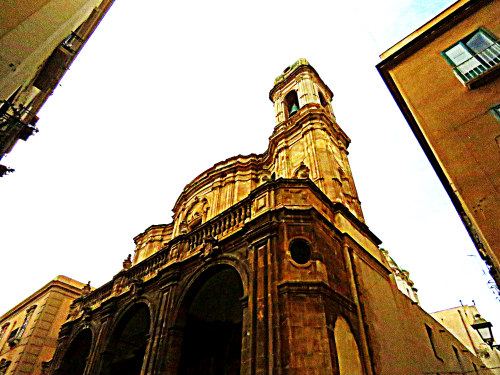If you have already had the opportunity to explore the beauties of Etna and the shores that surround the great volcano, perhaps your next trip to Sicily can be dedicated to Trapani. This beautiful city is the land of sunsets!
Your excursion to the westernmost district capital of Sicily can be done in one day. But we always recommend to stop at least one night or two. So to see everything more calmly. Trapani is not only nature, history and wonders of the art … it is also flavours to taste. Tastes of Africa and Europe mixed together.
History of Trapani
When Trapani was founded by the Elimi population, its territory was still an island separated from the mainland by a marine channel – now drained. The sickle-shaped village (hence the name Drèpanon) increased its importance between the 9th and 8th centuries BC. It was thanks to Carthaginian influence. The action of Carthage made the city involved in the Punic Wars, then won by the Romans.
 the baroque cathedral- ph G.Musumeci
the baroque cathedral- ph G.Musumeci
The second glorious period of Trapani is the 9th century AD, thanks once again to African influences: the Arabs. The Normans will continue that inheritance. They will in particular develop the port and the sea trade, from the year 1100 onwards. Between the 15th and 19th centuries, Trapani competed with Palermo as the most important center in western Sicily. The development of salt processing, wine production (Marsala, for example) and finally tourism have made it a thriving city over time, and still today.
What to see in Trapani
If you are in Trapani, give yourself a few moments to stroll along the seafront. Or walk directly on the beach, so close to the ancient city center. The best view is from the so-called Tramontana Walls. From there you can admire the “sickle city” illuminated by the splendid sunsets over the sea. As you walk through the historic heart of Trapani, you should not miss some beautiful monuments: the baroque churches, such as the Cathedral of St. Lorenzo. Then also the Jesuit College, the Church of Purgatory, St. Mary of Itria.
Inside the church of Purgatory you can admire the scenic floats of the “Mysteries” that come out during the Good Friday procession. Also very beautiful are the noble palaces, some baroque, others – such as Giudecca tower – in Plataresque style. Or the Romanesque buildings including the church of St. Mary of Jesus. The city proudly shows sixteenth-century fortifications, including castles and turrets. Very famous ones: Ligny Tower, Colombaia Castle and the Bastion of the Impossible.
You cannot complete the tour of Trapani without dedicating a day to the nearby Erice, or a short excursion to the Egadi Islands and to the salt pools of Stagnone.
Taste and flavours of Trapani
 the Trapanese pesto-ph by Amire80
the Trapanese pesto-ph by Amire80
In Trapani you eat well, you eat tasty! Not only for the salt that is produced there and then sold throughout Italy. Try the Nubian red garlics, the couscous recipe – which is prepared with fish or vegetables in the Arab way – and Trapanese pesto. The typical pesto of this area is made up of a combination of ingredients. They are: red garlic, basil, tomato, pecorino cheese and the particular addition of almonds.
The ideal pasta that accompanies this pesto is the “busiate”, a sort of long thin macaroni twisted on a branch of buso tree or a wire. The fried fish, snails cooked with garlic and almond desserts of refined delicacy are also worth the tasting.
Useful information
How to reach Trapani: by car, from Palermo, via motorway A29. From Catania, A19 motorway with change in Palermoto the A29.
By airplane you can land at Birgi-Florio, the district’s airport. Or land at the airport Falcone and Borsellino of Palermo.
There are boats and ships that get to Trapani from Livorno, Cagliari but also from Tunis.